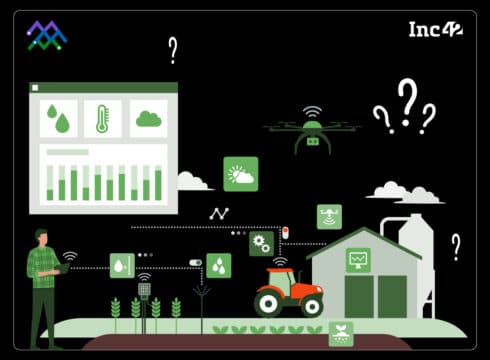BigHaat uses a full stack data platform to capture data and then accordingly uses the information to monitor consumer behaviour, sales and cropping patterns
BigHaat also enables the buyer side to adjudge whether the prices of the produce will go up and accordingly offer attractive terms to the customers.
As per a report, the homegrown agritech sector is projected to reach a market size of $34 Bn by 2027
Inc42 Daily Brief
Stay Ahead With Daily News & Analysis on India’s Tech & Startup Economy
Indian agriculture still conjures up the image of a destitute Indian farmer, bogged down by traditional farming practices. Fortunately, many agritech startups are out to change the perception and work from the ground up in resolving the issues related to one of the country’s biggest sectors.
However, what is powering this change? Speaking at Inc42’s The Makers Summit 2023, BigHaat’s cofounder and director Sachin Nandwana said that technology can help introduce sweeping changes across multiple supply and value chains.
Explaining his perspective, Nandwana said that BigHaat uses a full stack data platform that deploys 7-8 channels to capture data and then accordingly uses the information to monitor consumer behaviour, sales pattern, and cropping patterns.
The data helps it analyse and predict how much produce will be generated by a particular farmer and the impact of other factors such as pests and weather patterns on the yield.
This data helps the company deploy its pre-emptive information system to better tailor its products and warn farmers about an impending situation that could adversely impact their crops. According to Nadwana, this pre-emptive approach helps the company reduce its procurement cost by 20-25% and get better price realisation for farmers.
He added that the prediction model, which is based on AI and ML, helps the startup reduce crop loss and improve the production in many cases.
On the customer side of things, a deeper data channel on the farmer side helps BigHaat get direct information on sourcing and crop patterns. This information ranges from nutritional value to the presence of pesticides in the produce, which, then, enables BigHaat to provide better information on the products it sells to customers.
“Farmers can get pre-emptive advisories before diseases strike or address other issues, which, in turn, help them have a better produce and return on investments (RoI),” Nandwana added.
On the banking front, BigHaat enables the buyer side to adjudge whether the prices of produce will go up and accordingly offer attractive terms to the customers. It then takes into account external factors such weather changes or global issues to see if there will be demand and accordingly tailor financial products for the buyer.
Indian agritech space has scaled up massively in the past few years. This growth has largely been driven by local agritech players, which have fixed broken market linkages and supply chains in the fragmented agriculture sector.
As per a report, the homegrown agritech sector is projected to reach a market size of $24 Bn by 2025.
{{#name}}{{name}}{{/name}}{{^name}}-{{/name}}
{{#description}}{{description}}...{{/description}}{{^description}}-{{/description}}
Note: We at Inc42 take our ethics very seriously. More information about it can be found here.


